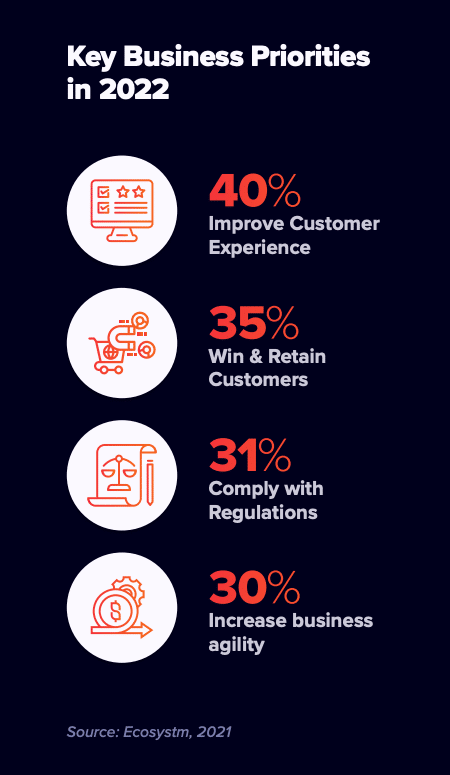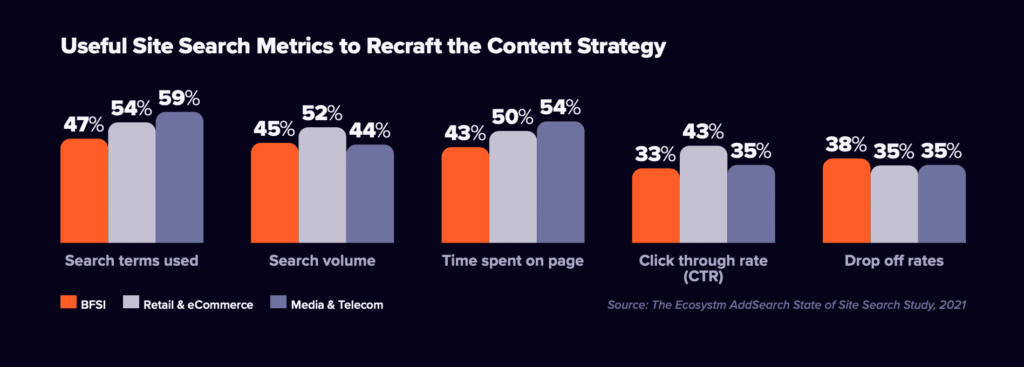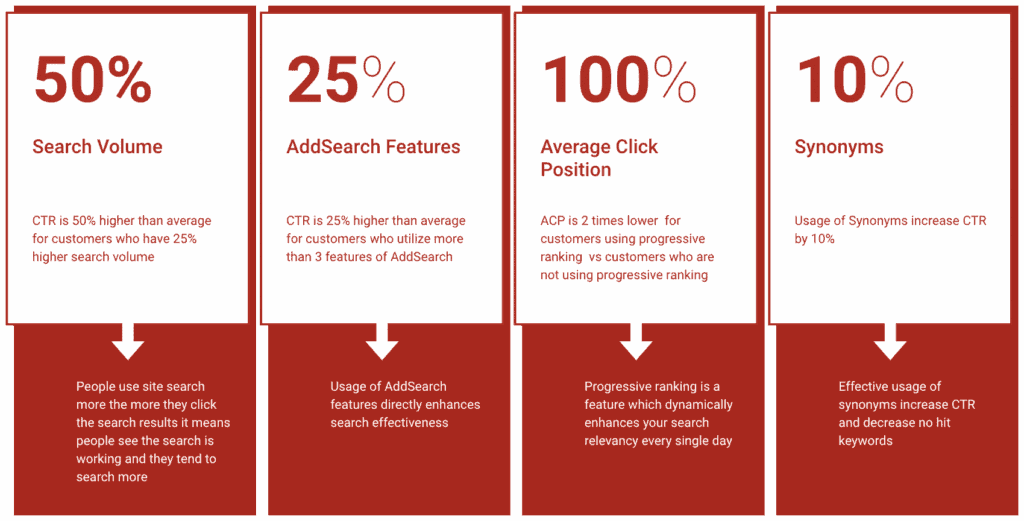Site search is considered an essential element in websites, but used effectively, it can be more, transforming into a tool that’s vital to helping you achieve your business goals. However, research on businesses’ priorities and how they are leveraging site search has been sparse. To help cover this deficit and equip our partners and customers to optimize their site search, we commissioned an independent global study last year. We’ve released the results here: A Global Study of Site Search. But we then decided to go a step further and combine what we found out in that study with some observations we had made through our experience in working with site search over a number of years. Check out our webinar, A Global Study of Site Search: Findings and Opportunities if you’d like to explore this further.
While the study was comprehensive and covered 500 organizations, in the webinar we took a closer look at three areas:
- What is the importance of site search for various organizations?
- How do organizations measure site search performance?
- What are the ways organizations want to develop site search in the future?
The Importance of Site Search

The 500 companies that we sampled were distributed across three industries: Banking, Financial Services and Insurance (BFSI); Retail and eCommerce; and Media and Telecom. We wanted to understand the different use cases for site search across verticals, and to find out what really mattered to different types of businesses.
Understanding what businesses are focusing on in 2022 was an important first step, so we asked our respondents what their key business priorities are.
While winning and retaining customers was one of the top priorities, as expected, we found that the pandemic has shifted customer expectations and to meet them, 40% of the businesses surveyed resolved to improve their customer experience.
Utku Yazici, our Product Director, pointed out that these factors are interconnected. A streamlined sales process, customer support and an excellent customer experience form the three pillars that lead to winning and retaining customers.
He also observed that although compliance may not seem directly tied to site search, it has a role to play. Especially in the case of enterprise customers, the GDPR and web accessibility requirements that have been written into regulation need to be addressed even in the site search function of their websites.
Search can play an integral role in enhancing business agility as well: as Murat Yamak, AddSearch Sales Director, shared, organizations must manage large, dispersed volumes of information, not just on their websites, but on internal databases for their employees like SharePoint and Google Workspaces, and unified search can help teams access essential information quickly.

Examining why businesses ultimately choose to invest in site search showed us that revenue growth was the main motivation across all three industries, and not just for e-commerce organizations. However, for BFSIs and Media & Telecom, time saving was a critical factor too, with 30% of each type of organization requiring this of their investment in site search. Site search also mitigates high support costs by allowing customers easier access to information.
Measuring Site Search Performance
Improving Customer Experience with Site Search
Four main factors come into play when assessing how site search can contribute to customer experience:
- Speed: While many of the businesses surveyed used page load speed as a metric, site search can have a big impact on the customer journey. This is especially true if large volumes of data are hosted on your website. Site search on your website acts almost like a ‘wormhole’ does in science fiction, shooting your customer at lightning-fast speeds to exactly the information they want to find. Unfortunately, search is often overlooked during the design phase of the website, in favor of other aspects such as the interface, navigation. In the initial stages, businesses also tend to only test their search on a few products.
- Relevance: Although speed is important, getting the right results is equally critical, and if customers don’t find what they are looking for, it can lead them off your site.
- Custom Responsive UIs: In today’s context it’s necessary to be able to meet your customers where they are, as many of them use mobile devices to find information, even if they may not complete their purchase until later. It becomes imperative then that your search UI is responsive on whatever device it encounters.
- Ease of Use: The end user is not the only one interacting with site search. Businesses should be able to adjust a good site search tool according to the users’ needs, to showcase products or promotions, or respond to end customers’ behavior patterns. The complexity of the tool affects its usability, determining who can adjust settings. If the tool is very complex, you would need a technical team to interact with it. However, if it can be easily controlled in response to your team’s requirements, you would be able to respond to the data faster.
Converting Customers through Site Search
As the survey showed that the second most important priority of businesses for 2022 was to win and retain customers, conversion is definitely a good measure of the effectiveness of site search. Different industries, however, have different ideas of what conversion entails. eCommerce organizations may have the most straightforward definition, with conversion being customers adding items to their shopping cart or finalizing their transactions. Other industries may be more information-focused or have other goals such as generating leads, engaging readers.
Research shows that more customers are converting through site search. They use it to access the area of the site they are looking for directly. To enable this, it helps to consider what role site search plays in your website’s goals. The placement of the search bar within your website is another factor.

For users to make educated decisions about the configuration changes in response to customer behavior, analytics tools such as Google Analytics and Adobe Analytics can be integrated in addition to the native dashboard. This combined integration can let you see clearly the impact of search on conversion rates.
Using Site Search to Create Relevant Content
Analyzing your site search data can yield a lot of information about what your customers are looking for. This allows you to tailor your content to engage their attention and lead them through the funnel.
When respondents were asked about the most important metrics in creating content for customers, the areas of interest were threefold:
- Which search terms lead customers to the website’s most important pages?
- When visitors search the most popular keywords, which pages do they end up on?
- What are the Click Through Rate (CTR) and Average Click Position (ACP) for the most important keywords?

Knowing these metrics gives you the power to uncover hidden opportunities. For example, combining the data for keywords and CTRs allows you to ensure that the most important keywords for your business have a high click through rate. Making a list of keywords that you target and revisiting them often to compare against popular searches can help you to benchmark against actual customer requirements. Utku breaks down the metrics and their uses further in A Global Study of Site Search: Findings and Opportunities; watch the replay to find out more.
The Relationship between Search Volume, CTR, ACP and AddSearch Features
In addition to the research we commissioned with Ecosystm, we analyzed some of our internal data to find out the links between different aspects of site search performance.
We examined four dimensions: Search volume and Click Through Rate, the use of AddSearch features, Average Click Position and Progressive Ranking, and the use of synonyms.

Some of the results are intuitive, for example a higher search volume can boost CTR. When people see search is working, they tend to click more. But we also found that just a 25% increase in search volume can push CTR 50% higher than average. Unfortunately, the opposite is also true: if people can’t find what they’re looking for, they tend to leave your website for others or if you’re lucky, they use other navigation features.
How can you help them? Use AddSearch features like progressive ranking. Just by using over 3 AddSearch features, our data showed that users could boost their CTR 25% higher than the average of around 50%. Progressive ranking also helped customers find their result faster, as ACP was two times lower, since it moves what people are searching for higher in the results. The use of synonyms helped raise CTR by 10%, as they make it more likely that customers will find what they are looking for on your site instead of getting a null result.
If you’re an existing customer wondering how to implement some of the features, or need help optimizing your site search, speak to our support team; they know the ins and outs of AddSearch and will make sure you’re using our features to maximum advantage. We also have a blogpost about the ways our features have solved problems for other customers, in case you’d like to know more: How to Solve Common Content Discovery Challenges in Site Search.
Future Site Search Capabilities
The study also examined what businesses are looking for in terms of site search capabilities in 2022 and beyond. At first glance, the requirements seemed somewhat basic because many AddSearch customers have harnessed these tools already. However, as with metrics, the needs of each industry vary. This makes it likely that some have not yet discovered the true potential of site search in achieving business objectives, while others such as eCommerce are ahead of the game.
While features like showing popular searches and enabling synonyms are fundamental to site search as it is now, companies who want to optimize their digitalization and have not yet optimized these areas can reap benefits from taking advantage of them to make their site search effective even now.
Ensuring accessibility to be inclusive to all visitors and meet regulatory needs is one of our focus areas. We continuously develop it because this is important to our mission to help organizations make their information discoverable.
You must be able to track the impact of site search features and how they help your customers convert to make educated decisions. This is another area that we keep refining to give our users the best and most effective site search experience, growing their revenue.
The use of AI to automate the ranking of search results is also a progressive field for the future. It allows users to optimize their websites without needing to be as hands-on, especially when dealing with large quantities of content.

To prepare our partners and customers for the future of site search, we also took a deeper dive into each of the three fields. Check them out if you’d like to explore the expectations for your industry, and benchmark against your peers. Whether you’re in Banking, Financial Services, & Insurance, Retail & eCommerce, or Media & Telecom, we have insights for you. Or if you’d like customized solutions, ask our team who are standing by to help you achieve your business goals for 2022!


